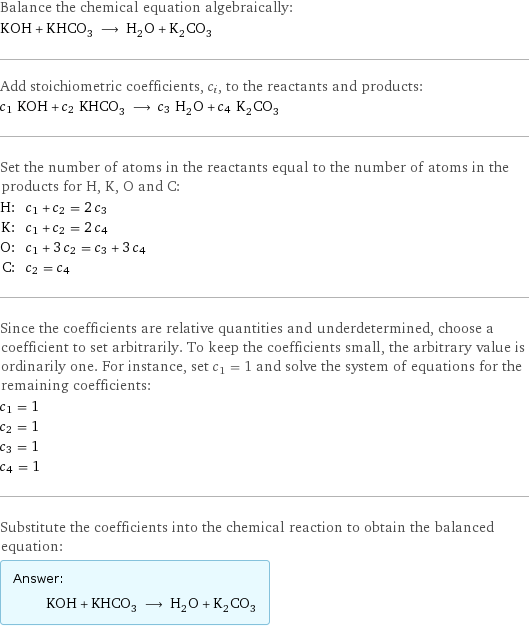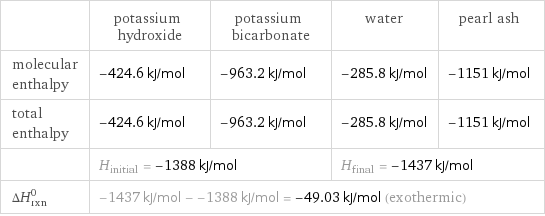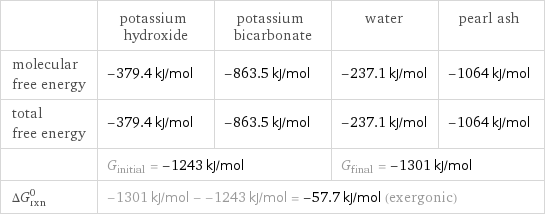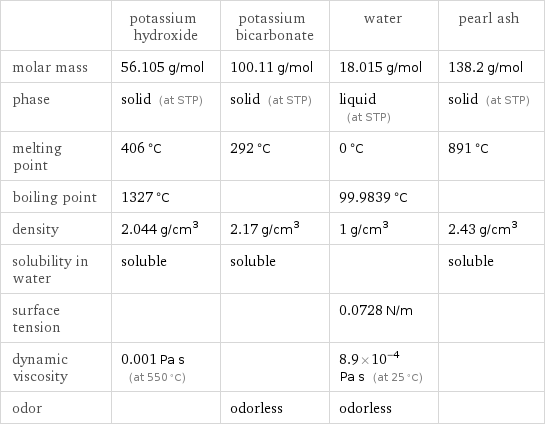Input interpretation

KOH potassium hydroxide + KHCO_3 potassium bicarbonate ⟶ H_2O water + K_2CO_3 pearl ash
Balanced equation

Balance the chemical equation algebraically: KOH + KHCO_3 ⟶ H_2O + K_2CO_3 Add stoichiometric coefficients, c_i, to the reactants and products: c_1 KOH + c_2 KHCO_3 ⟶ c_3 H_2O + c_4 K_2CO_3 Set the number of atoms in the reactants equal to the number of atoms in the products for H, K, O and C: H: | c_1 + c_2 = 2 c_3 K: | c_1 + c_2 = 2 c_4 O: | c_1 + 3 c_2 = c_3 + 3 c_4 C: | c_2 = c_4 Since the coefficients are relative quantities and underdetermined, choose a coefficient to set arbitrarily. To keep the coefficients small, the arbitrary value is ordinarily one. For instance, set c_1 = 1 and solve the system of equations for the remaining coefficients: c_1 = 1 c_2 = 1 c_3 = 1 c_4 = 1 Substitute the coefficients into the chemical reaction to obtain the balanced equation: Answer: | | KOH + KHCO_3 ⟶ H_2O + K_2CO_3
Structures

+ ⟶ +
Names

potassium hydroxide + potassium bicarbonate ⟶ water + pearl ash
Reaction thermodynamics
Enthalpy

| potassium hydroxide | potassium bicarbonate | water | pearl ash molecular enthalpy | -424.6 kJ/mol | -963.2 kJ/mol | -285.8 kJ/mol | -1151 kJ/mol total enthalpy | -424.6 kJ/mol | -963.2 kJ/mol | -285.8 kJ/mol | -1151 kJ/mol | H_initial = -1388 kJ/mol | | H_final = -1437 kJ/mol | ΔH_rxn^0 | -1437 kJ/mol - -1388 kJ/mol = -49.03 kJ/mol (exothermic) | | |
Gibbs free energy

| potassium hydroxide | potassium bicarbonate | water | pearl ash molecular free energy | -379.4 kJ/mol | -863.5 kJ/mol | -237.1 kJ/mol | -1064 kJ/mol total free energy | -379.4 kJ/mol | -863.5 kJ/mol | -237.1 kJ/mol | -1064 kJ/mol | G_initial = -1243 kJ/mol | | G_final = -1301 kJ/mol | ΔG_rxn^0 | -1301 kJ/mol - -1243 kJ/mol = -57.7 kJ/mol (exergonic) | | |
Equilibrium constant
![Construct the equilibrium constant, K, expression for: KOH + KHCO_3 ⟶ H_2O + K_2CO_3 Plan: • Balance the chemical equation. • Determine the stoichiometric numbers. • Assemble the activity expression for each chemical species. • Use the activity expressions to build the equilibrium constant expression. Write the balanced chemical equation: KOH + KHCO_3 ⟶ H_2O + K_2CO_3 Assign stoichiometric numbers, ν_i, using the stoichiometric coefficients, c_i, from the balanced chemical equation in the following manner: ν_i = -c_i for reactants and ν_i = c_i for products: chemical species | c_i | ν_i KOH | 1 | -1 KHCO_3 | 1 | -1 H_2O | 1 | 1 K_2CO_3 | 1 | 1 Assemble the activity expressions accounting for the state of matter and ν_i: chemical species | c_i | ν_i | activity expression KOH | 1 | -1 | ([KOH])^(-1) KHCO_3 | 1 | -1 | ([KHCO3])^(-1) H_2O | 1 | 1 | [H2O] K_2CO_3 | 1 | 1 | [K2CO3] The equilibrium constant symbol in the concentration basis is: K_c Mulitply the activity expressions to arrive at the K_c expression: Answer: | | K_c = ([KOH])^(-1) ([KHCO3])^(-1) [H2O] [K2CO3] = ([H2O] [K2CO3])/([KOH] [KHCO3])](../image_source/69c19934664698402ddbc0937763e1ad.png)
Construct the equilibrium constant, K, expression for: KOH + KHCO_3 ⟶ H_2O + K_2CO_3 Plan: • Balance the chemical equation. • Determine the stoichiometric numbers. • Assemble the activity expression for each chemical species. • Use the activity expressions to build the equilibrium constant expression. Write the balanced chemical equation: KOH + KHCO_3 ⟶ H_2O + K_2CO_3 Assign stoichiometric numbers, ν_i, using the stoichiometric coefficients, c_i, from the balanced chemical equation in the following manner: ν_i = -c_i for reactants and ν_i = c_i for products: chemical species | c_i | ν_i KOH | 1 | -1 KHCO_3 | 1 | -1 H_2O | 1 | 1 K_2CO_3 | 1 | 1 Assemble the activity expressions accounting for the state of matter and ν_i: chemical species | c_i | ν_i | activity expression KOH | 1 | -1 | ([KOH])^(-1) KHCO_3 | 1 | -1 | ([KHCO3])^(-1) H_2O | 1 | 1 | [H2O] K_2CO_3 | 1 | 1 | [K2CO3] The equilibrium constant symbol in the concentration basis is: K_c Mulitply the activity expressions to arrive at the K_c expression: Answer: | | K_c = ([KOH])^(-1) ([KHCO3])^(-1) [H2O] [K2CO3] = ([H2O] [K2CO3])/([KOH] [KHCO3])
Rate of reaction
![Construct the rate of reaction expression for: KOH + KHCO_3 ⟶ H_2O + K_2CO_3 Plan: • Balance the chemical equation. • Determine the stoichiometric numbers. • Assemble the rate term for each chemical species. • Write the rate of reaction expression. Write the balanced chemical equation: KOH + KHCO_3 ⟶ H_2O + K_2CO_3 Assign stoichiometric numbers, ν_i, using the stoichiometric coefficients, c_i, from the balanced chemical equation in the following manner: ν_i = -c_i for reactants and ν_i = c_i for products: chemical species | c_i | ν_i KOH | 1 | -1 KHCO_3 | 1 | -1 H_2O | 1 | 1 K_2CO_3 | 1 | 1 The rate term for each chemical species, B_i, is 1/ν_i(Δ[B_i])/(Δt) where [B_i] is the amount concentration and t is time: chemical species | c_i | ν_i | rate term KOH | 1 | -1 | -(Δ[KOH])/(Δt) KHCO_3 | 1 | -1 | -(Δ[KHCO3])/(Δt) H_2O | 1 | 1 | (Δ[H2O])/(Δt) K_2CO_3 | 1 | 1 | (Δ[K2CO3])/(Δt) (for infinitesimal rate of change, replace Δ with d) Set the rate terms equal to each other to arrive at the rate expression: Answer: | | rate = -(Δ[KOH])/(Δt) = -(Δ[KHCO3])/(Δt) = (Δ[H2O])/(Δt) = (Δ[K2CO3])/(Δt) (assuming constant volume and no accumulation of intermediates or side products)](../image_source/d947d1e925a0556203182fecb99fc45a.png)
Construct the rate of reaction expression for: KOH + KHCO_3 ⟶ H_2O + K_2CO_3 Plan: • Balance the chemical equation. • Determine the stoichiometric numbers. • Assemble the rate term for each chemical species. • Write the rate of reaction expression. Write the balanced chemical equation: KOH + KHCO_3 ⟶ H_2O + K_2CO_3 Assign stoichiometric numbers, ν_i, using the stoichiometric coefficients, c_i, from the balanced chemical equation in the following manner: ν_i = -c_i for reactants and ν_i = c_i for products: chemical species | c_i | ν_i KOH | 1 | -1 KHCO_3 | 1 | -1 H_2O | 1 | 1 K_2CO_3 | 1 | 1 The rate term for each chemical species, B_i, is 1/ν_i(Δ[B_i])/(Δt) where [B_i] is the amount concentration and t is time: chemical species | c_i | ν_i | rate term KOH | 1 | -1 | -(Δ[KOH])/(Δt) KHCO_3 | 1 | -1 | -(Δ[KHCO3])/(Δt) H_2O | 1 | 1 | (Δ[H2O])/(Δt) K_2CO_3 | 1 | 1 | (Δ[K2CO3])/(Δt) (for infinitesimal rate of change, replace Δ with d) Set the rate terms equal to each other to arrive at the rate expression: Answer: | | rate = -(Δ[KOH])/(Δt) = -(Δ[KHCO3])/(Δt) = (Δ[H2O])/(Δt) = (Δ[K2CO3])/(Δt) (assuming constant volume and no accumulation of intermediates or side products)
Chemical names and formulas

| potassium hydroxide | potassium bicarbonate | water | pearl ash formula | KOH | KHCO_3 | H_2O | K_2CO_3 Hill formula | HKO | CHKO_3 | H_2O | CK_2O_3 name | potassium hydroxide | potassium bicarbonate | water | pearl ash IUPAC name | potassium hydroxide | potassium hydrogen carbonate | water | dipotassium carbonate
Substance properties

| potassium hydroxide | potassium bicarbonate | water | pearl ash molar mass | 56.105 g/mol | 100.11 g/mol | 18.015 g/mol | 138.2 g/mol phase | solid (at STP) | solid (at STP) | liquid (at STP) | solid (at STP) melting point | 406 °C | 292 °C | 0 °C | 891 °C boiling point | 1327 °C | | 99.9839 °C | density | 2.044 g/cm^3 | 2.17 g/cm^3 | 1 g/cm^3 | 2.43 g/cm^3 solubility in water | soluble | soluble | | soluble surface tension | | | 0.0728 N/m | dynamic viscosity | 0.001 Pa s (at 550 °C) | | 8.9×10^-4 Pa s (at 25 °C) | odor | | odorless | odorless |
Units
